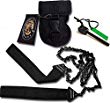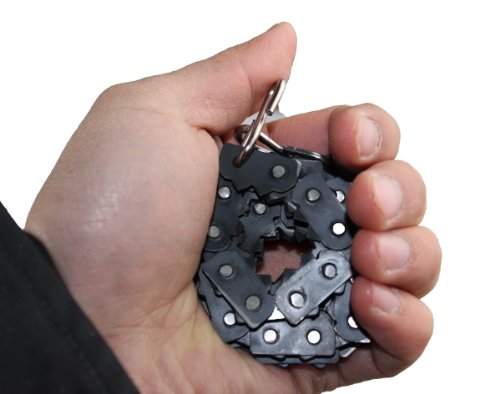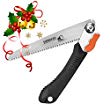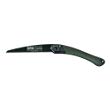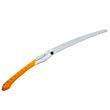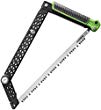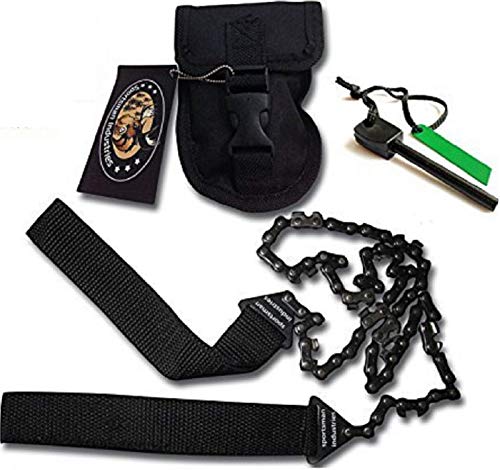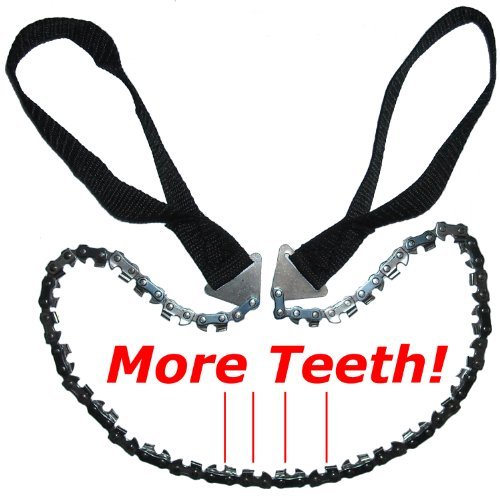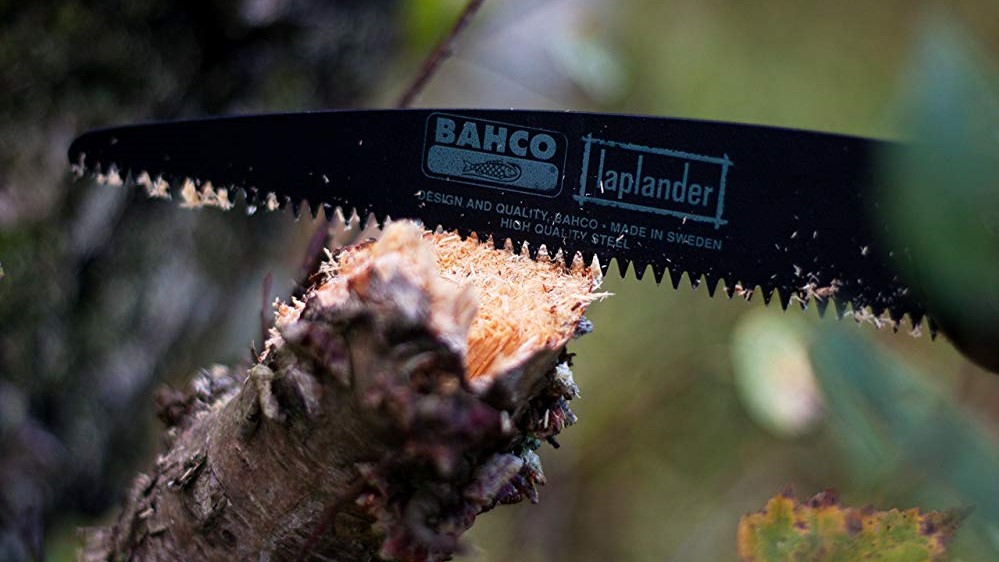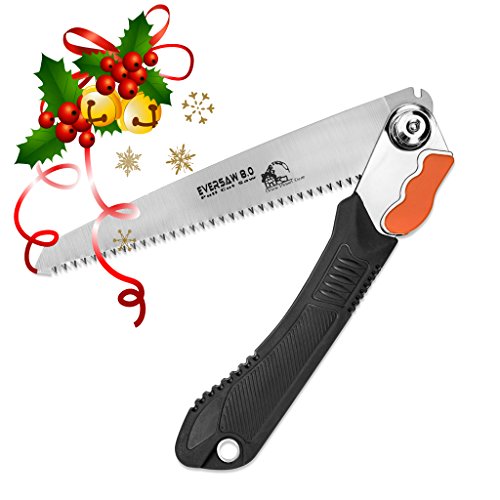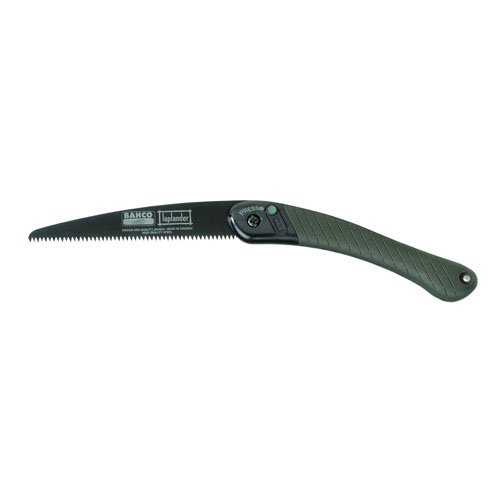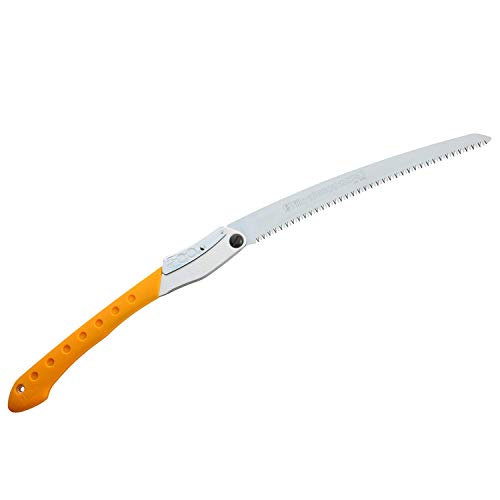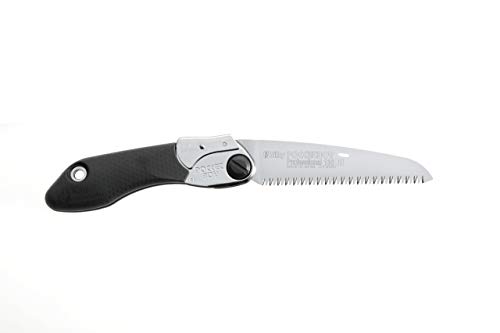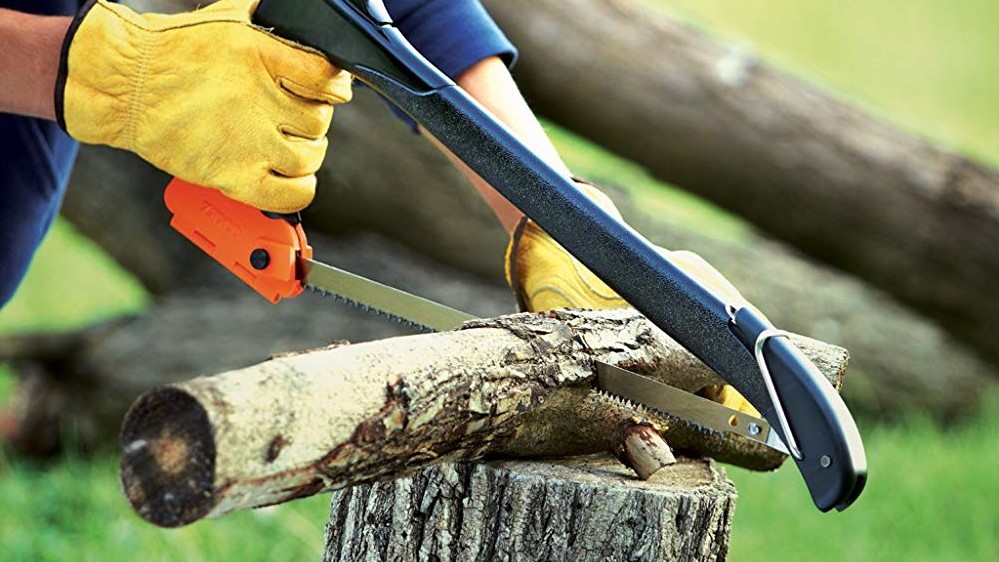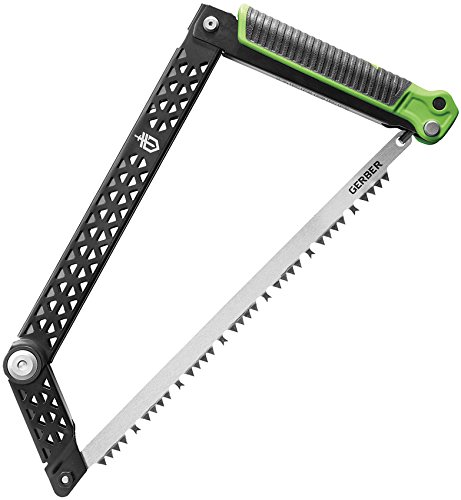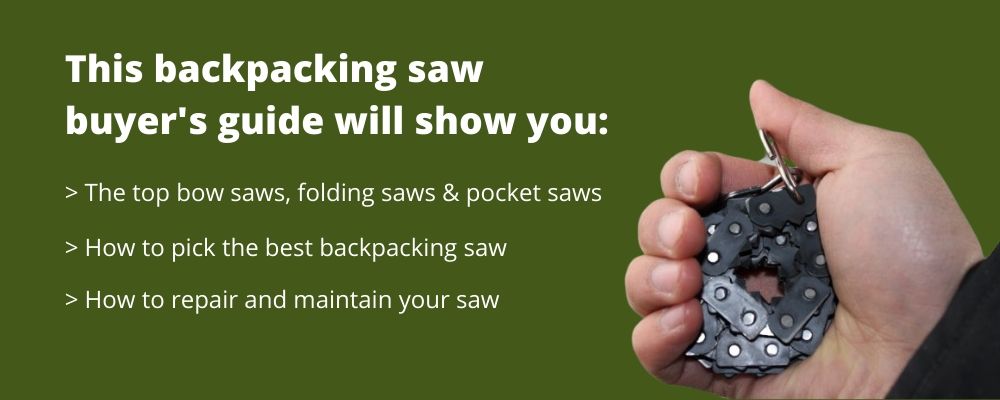
UPDATED JANUARY 2020
When we’re heading into the wilderness for a backpacking trip, it’s critical that our gear is lightweight, compact, and durable. And these qualities are especially important when selecting the best backpacking saw to take into the backcountry with you.
More...
Not only must the saw meet these criteria, but we also need specific types of saws meant for survival and bushwhacking – not the old ripping saw from grandpa’s workbench.
So when figuring out which saw to buy, first consider these three main categories:
- 1Pocket chainsaws
- 2Folding saws
- 3Bow saws
Each of these saws has its own pros and cons and choosing the best one isn’t always easy. That’s why we’re going to take an in-depth look at exactly which saw is right for you and up to the task of bucking limbs in the wilderness.
Comparison Chart - Best Backpacking Saws
Name | Price | Weight | Rating | Notes |
|---|---|---|---|---|
$$$ | 5 oz | Comes with high carbon 65mn thick chain that can be easily re-sharpened with a 5/32 round chainsaw file over and over again. | ||
$$$ | 6.4 oz | Multi Purpose - Handy at home for trimming trees and pruning branches, plus Outdoor Camping and Survival Uses. | ||
$$$ | 6.4 oz | Ideal for sensitive and arthritic hands | ||
$$$ | 5 oz | Ideal for survivalists on a shoestring budget | ||
$$$ | 10.1 oz | EverSaw 8.0 is a high quality tool with a Lifetime Warranty | ||
$$$ | 7 oz | Ideal for experienced shelter builders and woodworkers | ||
$$$ | 14.2 oz | Only the BigBoy2000 with XL teeth has a curved blade | ||
$$$ | 5.6 oz | Product applications include pruning/trimming, lawn/garden, hunting/ outdoors | ||
$$$ | 2.2 lbs | Aggressive Sidney Rancher Blade: The Sidney Rancher II is custom designed and favoured by those seeking an extremely aggressive and long lasting blade. | ||
$$$ | 1 lb | It utilizes 4 pivot points to effectively cut larger diameter wood while using the full length of the blade | ||
$$$ | 2.64 lbs | Full tang stainless steel axe blade & polymer handle with saw blade storage | ||
$$$ | 2.88 oz | Ergo handle with knuckle protector provides comfort and safety. |
Pocket Chainsaws
No, we’re not talking about a two-stroke, oil-hungry machine.
These are based on the same concept as the modern gas engine chainsaw but instead, they operate by hand-power and can be packed down into a tiny, lightweight package.
One major factor to watch out for when purchasing a pocket chainsaw is the longevity and durability of the product. Be sure to analyze carefully how well constructed the pocket saw is. As Les Stroud found out on an episode of the popular show “Survivorman”, many pocket chainsaws are cheap gimmicks and will leave you stranded after they break.
Ideal for: Lightweight hikers who want a quality saw!
This pocket chainsaw goes above and beyond the call of duty with a reputation for durability, ergonomics, and sharp cutting teeth.
Essentially this is a small caliber modern chainsaw blade attached to two webbing handles for easy grip and long use. Why does this stand out?
- Webbing handles are easy to use by providing a large area to grip
- Riveted chainsaw blade is solid steel and sturdy!
- Can be sharpened with any 5/32″ chainsaw file for continued use
- Lifetime guarantee
Really, the only weak point of the Sportsman Pocket Chainsaw 36″ is the webbing strap handles which can be easily replaced in the metal anchors if ever they wear out in the field. I really like the longer 36″ length which allows for more efficient stroke lengths as you can draw the saw across the wood in longer strokes before having to switch direction when compared to shorter saws.
Keeping it simple means sticking with the tried and true chainsaw blade tooth pattern. This means you can sharpen this saw with a chainsaw sharpener, too!
- Cuts in both directions
- Metal handle outriggers
- Blades on every link
With a bi-directional cut and blades on every link of the chain, this saw is ready to cut fast. Of course, the more teeth, the harder each pull will be so you’ll have to put some effort into it. You’ll be rewarded with a faster cut than most saws, though.
I’m not impressed with the simple webbing handles, but users love them and simple is sometimes better. Overall everything about this saw is boiled down to just what you need to make a cut and nothing more.
One good thing about this minimalist approach is a lightweight finished product that packs down to fit in a pocket or pack easily.
Best for fast cutting when you want to put your back into it!
Ideal for: Sensitive or arthritic hands.
One of the best aspects of a pocket chainsaw is that they’re small, flexible, and lightweight. This means you can carry these saws in your backpack without having to strap them to the outside or worry about the teeth chewing up other items in your pack. Compared to folding saws and bow saws, pocket chainsaws are much more efficient to carry into the backcountry.
With the Survival Pocket Hand Chainsaw, you’re going to get a different set of saw teeth than the Sportsman Pocket (styled after a gas chainsaw blade). In my experience, these smaller and more aggressive teeth are great for cutting across the grain especially on green wood – an area where other types of saws often fall short.
- Smaller teeth – usually more effective on green wood
- T-shaped handle for improved ergonomics
- May not pack as small as the Sportsman Pocket due to larger handles
This is a great tool to compare with the Sportsman Pocket Chainsaw 36″ and probably has a leg-up for extended use though the Sportsman Pocket may pack down smaller.
Pocket Chainsaw – Razor Sharp Self Cleaning 25.5 – [Best Budget Buy]
Ideal for: Survivalists on a shoestring budget.
Effectively the same design as the Sportsman Pocket, this saw is quite a bit shorter at only 25.5″. This means you’ll have to make more strokes per cut, however, you’ll have the advantage of a lighter overall saw due to the reduced length. For those looking to minimize on weight – this is an excellent option with all the reliability of the Sportsman Pocket. Like the Sportsman Pocket, this saw is highly efficient as the teeth are aligned bidirectionally to cut on both the forward and back strokes.
Here’s why you might consider Pocket Chainsaw instead of the Sportsman Pocket Chainsaw 36″:
- You prefer a lighter design
- You want to save money (half the price)
- You love the design
For these reasons, however, you might consider the Sportsman Pocket Chainsaw 36″ a winner:
- You plan to cut often or larger diameter limbs
- You prefer a longer cut length
- You prefer the manufacturer warranty
This might be a good option for those looking to save money, weight, or space.
Where Pocket Chainsaws Excel
Pocket chainsaws are basically a length of a real chainsaw blade with ergonomic handles on each end. Cheap ones are made from wire with burrs on it and these tend to break easily – avoid them.
These saws excel when you don’t have much space and you’ll only need occasional use.
PROS
CONS
Folding Saws
These seemingly tiny saws can really pack a punch!
I have always been impressed by the reliability and efficiency of folding saws and their diamond-sharp blades.
Generally, a double row of razor-sharp teeth acts to cut in both directions on the forward and back stroke of the saw. These saws are usually quite lightweight and seem to hold their performance forever!
Because these saws have a dedicated handle and a more robust design than pocket chain saws, you can use them for more delicate tasks such as ripping a board, cutting joints, or other straight-edge tasks that a rounded saw can’t handle.
This pull-cut saw is based on a Japanese style saw that has origins in the beautiful intricate woodworking of yesteryear. Of course, it’s ready for the woods with modern features.
- One-button folding
- 8″ blade
- 10 ounces
Like most folding saws, the blade tucks away into the handle when not in use. Unlike many saws, however, this one comes with a lifetime warranty.
I will say that I appreciate they made the blade tighten-able so you can adjust the blade tension to your needs.
Of course, the biggest downfall of the folding saw is that the blades aren’t replaceable. Because of the rows of tiny pull-cutting teeth, most people won’t be able to sharpen the saw either. That means if (when) you dull the saw, you’ll have to replace the whole thing.
Best for a rubberized ergonomic handle and one-button folding.
Ideal for: Experienced shelter builders and woodworkers.
Many folding saws are meant for limb-cutting only and feature a recurved blade. Bahco decided to accommodate those of us with a little woodworking knowledge and instead they created the Laplander Folding Saw with a straight edge blade. This is an awesome feature for cutting joints, tenons, and any fine cutting that might be needed for advanced shelter building.
Streamlined and featuring a safety lock so the saw doesn’t fold in on your hand (ouch), the blade is affixed to a dual-component plastic handle with excellent grip. The tooth setting is meant to be able to handle green and dry wood, bone, and plastic for any situation you might find yourself in. It’s even coated to prevent rust over the long term which will help extend the life of the saw, although the coating will eventually rub off with tons of cutting.
- 7 TPI blade is meant to cut multiple materials
- Safety lock on the blade
- Dual component handle for great grip
Silky Professional Series BIGBOY 2000 – [Best Multi-use Saw]
Ideal for: Around the yard and in the woods!
If you’ve got room in your pack to make your saw a priority, then this is the saw that belongs on the trail with you. For those of us who may be heading into the wood specifically to make sawdust, this 14″ behemoth of a folding saw is guaranteed to chuck all the wood that you can throw at it.
With 5.5 teeth per inch and a 16oz weight, you’re going to get a serious amount of performance for what you’re carrying. This saw will save you tons of time over more compact saws as the aggressive teeth and longer stroke length should make quick work out of whatever you’re bucking.
One major consideration is that the saw has a curved blade so it won’t be appropriate for cutting fine lines and joinery. However, if you need to cut down large diameter trees and limbs, this is your choice.
- Aggressive tooth set
- Large handle and blade mean more leverage
- Longer stroke length will help to make quick work out of large tasks
This might be a good choice for around the house as well!
Ideal for: Lightweight hikers or survivalists with tiny kits.
On the other end of the spectrum from the 14″ monster we just took a look at, this tiny little pocket saw is a great choice for occasional small use and lightweight.
Weighing less than 6oz, you’ll have the same double row of sharp teeth with a compact form factor of 5″ on the saw length. For those with large hands, this saw will be difficult in the hands but should make quick work out of the occasional task.
You’ll have the benefit of lighter weight, smaller size, and less space taken up in the pack.
- Great for occasional use and lightweight
- Not meant to take care of large or frequent cutting tasks
Where Folding Saws Excel
These saws have a lot more precision than a chainsaw. While chainsaws may be mostly limited to cutting things to length, a folding saw is capable of almost any woodworking saw task – provided you have the skills and patience.
These should be carried when you suspect you’ll have a regular use for precision cutting. They’re also the only type of saw suitable for ripping wood to width.
Folding saws excel when you want something more robust than a pocket chainsaw yet smaller and lighter than a bow saw.
PROS
CONS
Bow Saws
Bow saws take it a step above folding saws by providing a more durable frame for the saw to allow better efficiency and control of the cut. Most bow saws can fold and disassemble for transport and then be put together to get the best of both worlds – portability and performance. Though they’re more efficient, they’re generally larger and heavier than other options.
It seems hard to find quality products anymore, but that’s not the case here. The Boreal 21 is a bow saw based around a high carbon blade that has been heat treated for longevity.
- 21″ saw
- 17 ounces
- Automatic tension adjustment
One of the coolest aspects of this saw is that you can deploy the saw without touching the sharp blade. When folded, the blad is safely tucked away inside the armature.
To get the saw ready to use, you literally just unfold the arms of the bow and you’re in business. Arroding to Boreal, once opened the saw is perfectly tensioned and comes with no tension adjustment.
Best for heavy cross-cutting work.
Ideal for: Saving pack space and keeping weight to a minimum.
Gerber has always been one of my favorite blade-makers for their balance of quality and price. This folding bow saw is meant to pack down flat without having to disassemble any parts of the saw. This means lightweight, portable, and convenient – hard to find in a bow saw.
Compared to many in this category, the Gerber Freescape Camp Saw is relatively light and packable thanks to the design. It’s also easy to replace with any 12″ saw blade. Major drawback? 12″ blade means you’ll be taking a lot of stroked to make a cut.
- Great for compact and light users
- Easily replaceable blade
- Gerber name
Ideal for: The gadget junkie!
This is an interesting multi-use take on a classic piece of woodsman gear: the axe. Combine axe, hammer, saw, and tent stake puller and what do you get? This mashup.
Make no mistake, this tool is going to perform four jobs in place of one – but it’s not going to do any of them as well as a dedicated saw or axe would. Why? Because the added weight of the axe will make sawing inefficient and the saw components will make chopping a pain in the butt.
However, this saw might be your choice if:
- You demand multi-use items and don’t want to carry both a saw and an axe
- You really feel the need for a tent stake hammer and puller
Note: This is different than the Zippo 4 in 1 Woodsman. They removed the tent stake puller. They also added the ability to store 2 saw blades in the handle when not in use. That means you’ve got a backup which is a really nice feature.
Bahco 30-Inch Ergo Bow Saw – [Best Overall Performance]
Ideal for: Serious cutting with great efficiency and precision!
Are you the woodchuck that could chuck wood? If so, this is the tool for your chucking.
With a full 30″ of blade length and both dry and green wood variations, the Bahco Ergo Bow Saw really is designed to destroy some wood! Buy the saw once and just swap blades for the most effective blade type based on the wood you’ll be cutting. It’s a great tool for both around the house and in the woods.
This may not be the best tool, however, for those seeking to keep pack space to a minimum or cut down on weight. Full steel tube construction won’t pack well and weighs quite a bit for extended carrying.
- Ideal for trail crews or dedicated cutting work
- Multiple blade types for different jobs
- Long stroke length for great efficiency
UPDATE: This saw is now available in 21″, 24″, and 30″ lengths.
Where Bow Saws Excel
Bow saws are probably the most reliable and long-lasting of the saw options here when it comes to cross-cutting. They’re limited, however, by the depth of their throat or the distance from the blade to the bow.
Bow saws belong in the pack of someone who needs to do a lot of cutting as efficiently as possible.
PROS
CONS
How to Choose the Best Backpacking Saw for You
Saw Uses
First I’d like you to ask yourself, “Why do I need a saw in my backpack?”
Your answer to this question will determine which type of saw you carry, how heavy it can be, and how much you want to spend on it. If you’re not 100% sure why you need a saw, then leave it at home.
Here are some uses for backpacking saws:
- Cutting fire wood
- Creating shelters
- Trail maintenance
Let’s explore each of these topics a little further.
Firewood
Cutting firewood on the trail is a little controversial. If you choose to burn when on the trail, please be sensible and safe. On top of that, be sure to follow Leave No Trace guidelines for wilderness fire use. Note: LNT discourages the use of saws for gathering firewood – you can learn more here.
For regular firewood cutting you’ll probably want a bow saw or folding saw. They’re both designed to stand up to heavier use and they have more ergonomic handles that transfer force better and reduce fatigue when cutting.
Shelter Making
Creating shelters is another potential use of a backcountry saw. Before building a shelter, however, be sure that it is an activity that is allowed on the public land where you are. Additionally, be sure to disassemble and disburse your shelter after you’re done with it to avoid visual and environmental impacts.
For shelter building, any saw will be of great help. However, unless you’re regularly building shelters, a high-quality pocket chain saw that you trust is a good balance of weight and bulk vs frequency of use.
If you think about it, most people will only be building a shelter in an emergency. Therefore it probably makes sense to carry a very lightweight, small saw like a pocket saw which you can pull out in a pinch but disappears in the pack for day-to-day use.
Note that building shelters should only be done in an emergency – use a tarp, tent, or another non-impactful shelter for everyday use.
Practice building shelters at home before you get into an emergency. Having a saw is nice, but any decent survival shelter should be able to be constructed without any tools at all. Having a saw is just the icing on top of the cake if you get into a pickle.
Trail Work
For trail maintenance, you’ll want to take the largest and most durable saw you can afford. Many portable saws just aren’t cut out for regular heavy trail work and won’t last long. Focus on the bow saw category for a workhorse of a saw you can rely on for trail work.
If you carry a saw in order to be a vigilante trail maintainer, good for you! Keep in mind that in some rare cases, however, only trail maintenance organization volunteers are permitted to do this work. If you are permitted to do this work, then the best saw you can carry is a bow saw. Their rigidity and aggressive blades make quick work of clearing blow-downs and overgrown trail corridors. Remember to check with the local trail organization or ranger station before going off on your own. It’s common that some trails get re-routed or shut down in certain areas. In this case, you’d be doing everyone disfavor by re-clearing a closed area.
Most dedicated trail crews carry chainsaws or larger hand saws for heavy work out there. Remember that helping clear the trail is a great way to pay back the community for the trails we all love, but no one expects you to clear a 24″ tree by yourself. Be safe and keep it reasonable.
Leaving a Trace
Using a saw in the woods almost always leaves a very visible impact on the world around you. The next hikers to come through have to look at whatever you’ve cut down.
In some cases, it’s even illegal to cut standing wood (including standing dead wood).
Leave No Trace principles would encourage us to only cut wood to built a shelter in a true emergency. By these guidelines, you would also be encouraged to only burn fallen wood no larger than your wrist.
Usually cutting wood is only legal in areas designated as BLM (Bureau of Lands Management) lands, “Forest”, or “Wilderness Area”. Of course, to make sure you don’t get a hefty fine you need to check with the ranger station governing the use of the land you’re traveling on before you go around hacking stuff down.
Please remember that you don’t have to cut down an entire tree to make a noticeable impact. Cutting low limbs is also a negative visual (and sometimes environmental) impact. I think every campsite I’ve visited has had a 100-yard radius of tree limbs cleared as high as a person can reach where people have cut, hacked, and broken limbs off to burn. It looks awful! Imagine hiking for days into a remote area just to find that the campsite has been cannibalized and looks ugly with severed limbs all around. This experience really detracts from the experience for others, so think twice before cutting.
Note: Felling standing trees should never be taken on in the backcountry. It’s dangerous work and you’re far from help if something goes wrong. Additionally, it’s extremely impactful to do so.
Repairing and Maintaining Your Saw
How to Sharpen a Pocket Chainsaw
There are tons of tools out there for sharpening chainsaws but for pocket chainsaws, it’s probably easiest, cheapest, and most feasible to sharpen them once in a while with a hand file.
It’s pretty easy to do but you’ll need to slow down, pay attention to details, and use a steady repeated hand to get good results.
This is one skill that’s probably easiest to learn visually so check out this awesome video below to get an idea of what the process is like.
Note: Part of the video is focused on sharpening the chain while on the saw but for our pocket chainsaws you’ll need to use a vise to hold it steady while you work. The embedded video here starts at the relevant segment.
You’ll need a set of round files to match the size of your saw teeth. This is measured by the radius of the inside curve of the teeth. Most commonly this is 3/16″ but other standard sizes include 5/32″ and 7/32″.
To get you on your feet, you’ll want a set of round files like this 3-piece set which covers all the common sizes.
Each time you sharpen your saw you’ll slowly remove metal until eventually your saw is spent and you’ll have to buy a new one. Try not to remove any more metal than necessary when sharpening your pocket chainsaw to preserve the life of your pocket chainsaw.
How to Sharpen Bow Saws
Beware that bow saws can have many different kinds of blades. These blades are substantially more intricate and harder to sharpen than chainsaw blades. That said, it’s possible to do and you can do your own maintenance if you choose. Buying a new blade may be quite a bit faster though…
If you choose to take on sharpening your bow saw blade you need to start by understanding how the teeth are designed. Then you’ll need a handful of files and a steady hand.
The following video shows how to sharpen bow saw blades that are made up of plain teeth and raker teeth – don’t worry, the video explains all the teeth and how to sharpen them.
Sharpening Folding Saws
Most folding saws are made with just plain tooth style saw teeth. These are often placed on curved blades and many of them are so narrowly placed that it’s impossible to get a file in there to sharpen them.
If you’re dead-set on sharpening your folding saw you can still pull it off. You’ll need a set of Needle Files or (preferably) a Feather File. Note that feather files are very specialized tools and poor quality ones are common – if you’re going to really get into saw sharpening make sure to spend top dollar on your files as a poor file will just undo your work.
When you’re ready to put the file to the metal be sure to watch this video for reference and then go get at.
Conclusion
If you’re serious about cutting around the house and in the woods, then you’ll need to consider a dedicated bow saw like the Bahco 30″ Ergo Bow Saw. While it won’t save weight or space in the pack, no other saw on our list is going to cut with its ease of use.
For the lightweight and compact type of hiker and survivalist, there’s nothing that will beat the performance of the Sportsman Pocket Chainsaw 36″ with its long stroke and bi-directional teeth. This little saw is a huge performer with one drawback: no flat cuts.
Remember to consider exactly what type of work you’ll need to do with your saw before making a purchase. Each type has advantages and disadvantages that must be carefully considered in order to make the best purchase for your needs!

